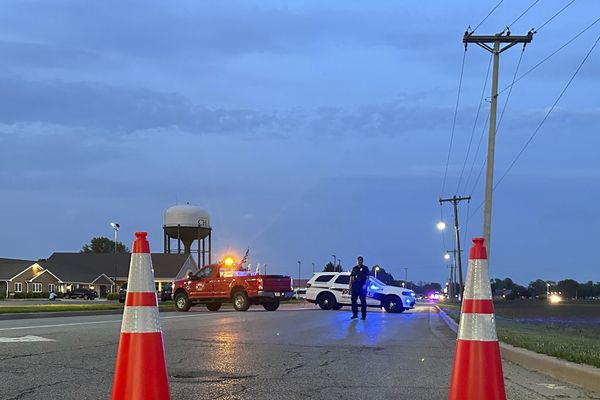Ukraine has carried out one of its biggest ever drone attacks on Russia, with videos showing a series of explosions and fires at power stations and refineries including in Moscow.
Russia’s defence ministry played down the overnight strikes. It said it had intercepted and destroyed 158 unmanned enemy aerial vehicles. These were shot down over 15 regions, it claimed.
The strikes came as Russia bombarded Ukraine’s second city of Kharkiv and made further incremental gains in the eastern Donbas region. Its forces have been rolling forward in recent weeks and are closing in on the city of Pokrovsk.
Footage posted on Telegram channels suggested some of the long-range Ukrainian drones hit targets deep inside Russia, causing damage. At least one struck an oil refinery in the Kapotnya district in south-east Moscow.
/1. Moscow oil refinery was targeted by drones tonight. pic.twitter.com/zEwRvLueAB
— Special Kherson Cat 🐈🇺🇦 (@bayraktar_1love) September 1, 2024
More drones hit a thermal power station in the Tver region, north of Moscow. There was an explosion at the Konakovo station, one of the biggest in Russia, at about 5am. An orange fireball engulfed several transformers.
Another coal-fired power plant at Kashira in the Moscow region was also reportedly hit. The extent of the damage was unclear. Three drones were allegedly used. Russian officials said others crossed into the Voronezh, Tula, Kaluga, Bryansk, Belgorod, Lipetsk and Kursk regions.
Oh wow, so you’re telling me striking critical infrastructure is a game two can play?
— Illia Ponomarenko 🇺🇦 (@IAPonomarenko) September 1, 2024
Ukraine has had yet another massive drone attack on Russia, one of the largest ever.
Given the fact that Russian air defenses are so weak in areas beyond immediate war zones (even in Moscow!),… pic.twitter.com/dXAOLCny1Q
Volodymyr Zelenskiy said Ukraine’s attacks on critical infrastructure inside Russia were an answer to the Kremlin’s repeated strikes on Ukrainian civilians and its own power infrastructure. “It is entirely justified for Ukrainians to respond to Russian terror by any means necessary to stop it,” he said.
He condemned Russia’s attack on Kharkiv on Sunday, when about 12 Iskander-M ballistic missiles pummelled the city. “Russia is once again terrorising Kharkiv,” Zelenskiy tweeted, adding that a rescue operation was carried out with “all the necessary means”.
The short-range rockets hit buildings including Kharkiv’s giant concrete Palace of Sport. Black smoke poured from a gaping hole in its roof. Ukraine’s air defences were unable to shoot down the Iskanders, which fly at 6,000km/h (3,730mph), said the regional prosecutor, Oleksandr Filchakov.
According to Kharkiv’s mayor, Ihor Terekhov, 44 people were injured in the latest strikes. Seven of the victims were children including a three-month-old baby boy.
Bombs hit Kharkiv’s Kyiv district, near the hydropark, and landed next to a shopping centre and metro in Saltivka. In 2022 the Russians shelled this north-eastern area repeatedly. Local people who lived in its high-rise apartment blocks spent months sheltering in the underground station.
Kharkiv was just hit by a dozen of Iskander missiles and S-300s, which Ukraine can't intercept. Multiple strikes across the city, including a sports facility and residential areas. This is the largest ballistic attack on Kharkiv yet—the city is basically an open target. pic.twitter.com/vqPMjxieif
— Maria Avdeeva (@maria_avdv) September 1, 2024
The newest salvo came after a Russian-guided bomb smashed into a 12-storey residential building in Kharkiv on Friday. Several people died including Veronika Kozhushko, an 18-year-old artist, and a 14-year-old girl who was outside in a playground, sitting on a bench.
Zelenskiy said that in the past week the Kremlin had launched more than 160 missiles of various types, as well as 780 guided aerial bombs and 400 drones. “To fully protect and safeguard our cities from this aggression, we need greater support for Ukraine’s rightful response,” he said.
He has repeatedly called for the Biden administration to permit Ukraine to use US-supplied Atacms rockets against military airfields on Russian territory. Visiting Washington last week, Ukraine’s defence minister, Rustem Umerov, gave US officials a list of potential high-value targets.
So far, however, the White House has refused to amend its red lines. The UK and France, which have supplied Kyiv with Storm Shadow and Scalp cruise missiles respectively, have not given permission either. They appear reluctant to act independently from the US.
Ukraine argues that destroying Russian airbases will protect its cities and help it to stem Russian advances in the east. In recent weeks Russian troops have made rapid progress. They are 5 miles from Pokrovsk, a key Ukrainian transport hub, and are approaching the neighbouring town of Myrnohrad.
Since 6 August, Ukraine’s armed forces have occupied 100 settlements in Russia’s Kursk region, after a surprise incursion. In recent days this offensive has slowed down. Russia has sent in troops as reinforcements from other parts of the frontline while continuing its push for Pokrovsk.
On Sunday Russia’s defence ministry said it had captured two more villages in Donetsk oblast, Ptyche and Vyimka. Thousands of civilians have left Pokrovsk after an order to evacuate. Shops, banks and businesses have closed in anticipation of an imminent Russian attack.







